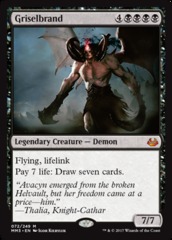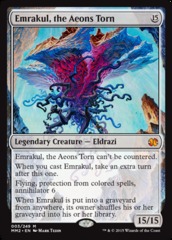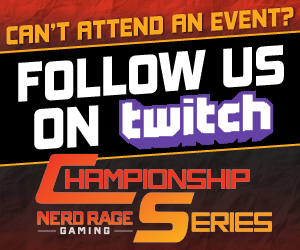Why We Love Legacy: Casey Laughman on Sneak and Show
One of the great things about Legacy is that the deckbuilding process for one of the format’s top decks goes like this:
- 3-4 copies of a card that can literally not be paid for by the manabase;
- 3-4 copies of a card that can technically be cast, for the low cost of 15 mana;
- 0-3 copies of a card that can technically be cast and costs less than 15 mana, but still requires 10 mana and triple blue;
- A bunch of ways to jam any combination of or simply all of those cards into play on turn 1.
You’ve probably guessed by now that I’m talking about Sneak and Show. Although, to be fair, I could be talking about a decent number of other decks.
Legacy is great.
Sneak and Show is my Legacy deck of choice, because I believe in playing entirely fair and balanced Magic. Of course, my definition of fair and balanced may vary slightly from yours. Regardless, any time that you can have one or both of these two in play on turn 1 or 2, you are doing it right.
How do we accomplish this? By abusing a few of the most abusable cards allowed in Legacy. Show and Tell allows you to cheat Emrakul, Griselbrand, Omniscience, or all of the above into play as early as turn 1. Sneak Attack requires slightly more setup and requires you to sacrifice whichever creature you cheat into play at the end of your turn, but that’s not a real big issue when you either get to whack your opponent for 15 (with an Annihilator 6 trigger) or hit them for seven, gain seven life, and draw a whole bunch of cards in exchange for a whole bunch of life.
There are a couple of different ways to build the deck, but my preferred build is Sneak and Show with Omniscience, so that’s what we’ll focus on here. Let’s start with the build I played last weekend at the Legacy CT, which is based on the list that Dan Savage has had success with on the SCG Tour.
The Deck
Sneak and Show, by Casey Laughman
Yes, that says The Locust God. More on that in a bit.
The basic plan is to have a Show and Tell, something to cheat into play with Show and Tell, and Force of Will backup. You can go off as early as turn 1, but usually turn 2-3 is better so you have an idea of what your opponent is playing and increase your odds of having a counter to protect your Show and Tell. Either way, you’re trying to force your opponent to have an answer for a ridiculously overpowered creature well before they’re prepared to deal with it.
The Untouchables
For Omniscience builds with a Cunning Wish sideboard:
4 Show and Tell
3 Griselbrand
3 Emrakul, the Aeons Torn
3 Omniscience
2-3 Sneak Attack
4 Brainstorm
4 Ponder
4 Force of Will
5 two-mana (Sol) lands
3 Lotus Petal
3 Cunning Wish
2ish Preordain
1 Intuition
Show and Tell is, obviously, Plan A.  Consider these two opening hands:
Consider these two opening hands:
Hand A: Show and Tell, Griselbrand, Ponder, Force of Will, Brainstorm, City of Traitors, Lotus Petal
Hand B: Griselbrand, Omniscience, Emrakul, Ponder, Force of Will, City of Traitors, Lotus Petal
Hand A is a snap keep every single time. Hand B has the potential to be even better, but is much iffier because you’re missing the critical piece to let you go nuts. In a vacuum, you should mulligan, because your only way to dig for the missing piece is Ponder, which requires you to burn your only blue source (Lotus Petal) and risk not having a blue card to pitch to Force. (If you know you’re playing a slower deck, you can keep Hand B, especially on the draw, but know that the fail rate is real.)
Sometimes you get Hand C: Show and Tell, Omniscience, Emrakul, Ponder, Force of Will, City of Traitors, Lotus Petal. Snap it off and enjoy having time to get lunch.
Sometimes you get Hand D: Show and Tell, Ponder, Brainstorm, Spell Pierce, Island, Scalding Tarn, Sneak Attack. Context is everything here, and 90 percent of the time, this hand is a mulligan even though it seems like one that gives you a lot of chances to find Show and Tell. With this hand, the odds are very good you’ll die before you ever find it. If that Spell Pierce is a Force of Will, this hand becomes much better, and is keepable in a lot of matchups.
Having said all of that, you have a lot of redundancy and a lot of ways to dig, so don’t be afraid to mulligan aggressively.
Of those ways to dig, Ponder and Brainstorm are mandatory 4-ofs, because they’re the best ways available to get deep into your library or shuffle it if needed. Don’t be afraid to shuffle off of Ponder if you need one specific piece and it’s not in the top three.
As for Brainstorm, I cannot stress this strongly enough: Do not Brainstorm lock yourself with this deck. Unless your only chance of survival is finding one thing right now, casting Brainstorm without a way to shuffle away dead cards is a bad idea, because you’re not interested in incremental advantages. You’re trying to go over the top ASAP, and having two cards on the top of your library that don’t work towards that specific goal is bad news.
Preordain is usually a two-of, but can be bumped up as necessary. It’s a solid draw spell, but it’s simply not as powerful as either Ponder or Brainstorm, so it’s not needed as a 4-of. It’s usually seen in larger numbers in decks that don’t run Omniscience.
Intuition is a one-of in the main, but it’s important because it gives you another way to find the missing piece. Because you can get three cards with the same name, you can cast it for Show and Tell, Omniscience, Emrakul or Griselbrand, depending on exactly what your hand is lacking. You can even cast it to get a Force of Will if you think you need a way to protect a Show and Tell on your turn. There have been numerous occasions where I’ve cast an Intuition (off of Sol land and Lotus Petal) at the end of my opponent’s first turn to find the missing piece, then untapped, played a second land and jammed Show and Tell.
Force of Will is Force of Will. It allows you to stick an early Show and Tell through countermagic and can keep you alive by countering something critical for free. If you’ve got a chance to go for it early with Force of Will backup, go for it. Make your opponent have two counterspells to stop you, and the chances of them having the counters and the mana to cast them are much lower on turns 1-3 than on turns 4-6.
Sneak Attack is plan B because the drawback is real, but sometimes, you need a way to get one of your big dumb creatures into play with haste. The good news is that Emrakul shuffles itself back into your library when it dies and Griselband lets you draw a bunch of cards, so you can set yourself up to do it again next turn. If you do land an early Sneak Attack, one of the most important things is knowing when to fight over it and when to let it go. If you’re set up to cast Show and Tell and Omniscience on your next turn to cast an Emrakul or a Griselbrand, it’s not worth burning countermagic to protect Sneak Attack if a hasty attack wouldn’t be lethal. If you don’t have Show and Tell but do have ways to take advantage of Sneak Attack, then be more aggressive in protecting it, because sometimes it’s your only way of winning.
Cunning Wish is mandatory in this list, but not necessary in lists with traditional sideboards. I’ll dig deeper into that in the sideboarding section.
The Flex Spots
2 Spell Pierce
1 Flusterstorm
1 Jace, the Mind Sculptor
1 The Locust God
Let’s talk about The Locust God, because I know that’s the one you’re most curious about. Basically, I was looking for another threat that could offer more than just a body. Making a bunch of insects with flying and haste seemed pretty good, and putting it into play off of Sneak Attack allows you to put it back in your hand at end of turn and have a repeatable threat to Sneak in.
I did manage to kill one opponent with it by putting it into play with Sneak Attack when he was at four life. Other than that, it didn’t do much, but I will be continuing to try it out to get some more information on whether it’s worth a spot or not. The Sneak Attack upside is very big, and you do have a bunch of ways to make a 4/4 Locust God into a 4/4 Locust God and several insects, so it can be a quick clock. The argument against it would be that it doesn’t do anything when it comes into play, which is a downside in a format such as Legacy. If you want something like that, Inferno Titan or one of the hasty dragons could fill this spot.
Jace, on the other hand, was underwhelming. A lot of the non-Omniscience builds run it, and it seems like it would be better there. I’m going to replace it with the third Sneak Attack moving forward; it felt like I was drawing Sneak Attack too much when I had three before, but with only two, I felt like I didn’t see it enough.
Spell Pierce and Flusterstorm are only flex spots in the most literal sense. Extra countermagic is good, and Flusterstorm is great to protect yourself from other spell-based combo decks. The main thing that is flexible about these cards is the exact numbers; depending on the meta, two Flusterstorm and one Spell Pierce could be better, or even one Flusterstorm, one Spell Pierce and one Counterspell. If you really want to live on the edge, you could replace these spells with Gitaxian Probe for another cantrip and a way to see if the coast is clear to go for it, but I would only do that if you expect a very creature-heavy meta.
The Mana Base
You need at least five Sol lands; the exact numbers don’t matter that much. City of Traitors is annoyingly expensive, so you could replace it with Crystal Vein if you have to. Or, you can max out on Ancient Tomb and only run one City or Vein.
You need Volcanic Islands (or Steam Vents), but you’ll fetch it much less than you will basic Island. Wasteland can be a big setback, so basic Island plus cantrip on turn 1 into Sol land and Show and Tell on turn 2 is much better than exposing a Volcanic Island to an early Wasteland.
Seven fetches let you get the blue you need and give you ways to shuffle away cards off of a Brainstorm. Four Scalding Tarns are mandatory, but the other three can be anything that fetches blue.
Three Islands and a basic Mountain let you work around Wasteland concerns. The Mountain gives you a way to have a land that can’t be Wastelanded, but can activate Sneak Attack. The basic Islands also let you be less concerned about Blood Moon, which is good considering that there are three of them in the sideboard.
Nineteen mana sources is fine, especially with three Lotus Petal. Be careful not to run out Petal until you need it; you don’t want to randomly lose it to an Abrupt Decay, then not have it when you need it. The one exception, of course, would be to pay the Thalia tax to cast Petal for 1 on one turn, then use it to cast Show and Tell or Sneak Attack on the next turn.
Gameplay
This list has seven counterspells, but it is not a control deck. It is a combo deck, and if you try to play it as control, you will lose. Your goal is to get a big ol’ beatstick into play as early as possible, and the counterspells are there to help facilitate that and keep you alive, not interfere with your opponent’s plans.
Here are some tips and tricks to keep in mind:
- Don’t be afraid to mulligan. You have a lot of ways to dig and a fair number of threats, so don’t keep a hand that is “good if I draw this and this.” Basically, you need three or four things: A threat; a way to cheat it in; the mana to do so; and (conditionally) protection for the cheat. If you know you’re playing against Burn and you have Show and Tell, mana to play it on turn 1 or 2 and Griselbrand, you don’t need to really worry about whether you have a Force or not. Conversely, if you’re playing against Stoneblade, you need the protection, but can afford to be a little bit slower, so you can keep a hand that is missing one or two pieces but has a couple cantrips.
- As previously stated, do not Brainstorm lock yourself. You’re not looking to get ahead on cards. You’re looking to have an Emrakul or Griselbrand in play early to put an immense amount of pressure on your opponent. Sometimes, the best thing you can do is be patient early instead of firing off a Brainstorm the first time you have an open blue mana.
- The ideal play is Show and Telling in an Omniscience, then casting Emrakul to take the extra turn and basically win the game. But if you feel confident you don’t have to worry about Omniscience getting blown up, you can get it into play early and cast your cantrips for free to find a threat. Cunning Wish helps immensely here.
- If you have Sneak Attack in play and Emrakul in hand, obviously you want to get the Flying Spaghetti Monster into play and get to wreckin’ stuff. But if you have Griselbrand, put it into play and draw seven cards before you attack. If you hit another red source — or already have an extra red — and Emrakul, congratulations on swinging for 22 damage and Annihilator 6 instead of a mere seven damage.
- If your Griselbrand is about to be hit with a Swords to Plowshares, the worst-case scenario should be seven new cards and the same life total you have before Swords is cast. The cards are likely to be more important than the life; unless, of course, you happen to be at six or less or are facing down a bunch of damage on the other side.
Sideboarding
One of the easiest things to do in Legacy is over sideboard, and I am often guilty of that. The nice thing about this particular sideboard is that it makes it almost impossible to over sideboard.
For the most part, you will be doing one of a few scenarios. You will be bringing in:
Blood Moon, (sometimes) Engineered Explosives and (sometimes) a Kozilek’s Return in place of countermagic, or;
Boseiju in place of a City of Traitors, or;
Nothing.
If you’re not sure what to do, take the third option. By having access to Cunning Wish, you can go to your sideboard if you absolutely need something.
I generally only bring in one Kozilek’s Return, because Cunning Wish lets you go get the other one. Against decks like Elves that are really looking to swarm the board, you can bring in both.
You will obviously never board in Eladamri’s Call, because it’s there solely for those situations where you have Omniscience in play, Cunning Wish in hand, and no Emrakul. Don’t board in the Traps, either, because when you need them, they’re likely to cost zero, and your chances of being able to Wish for them are greater than having them in your hand. This especially applies to Ravenous Trap, which you can’t cast for its mana cost.
One trick to keep in mind: After sideboarding, some decks bring in Ashen Rider to exile whatever you put in play off of Show and Tell. If you put Omniscience into play and have Cunning Wish in hand, you can respond to Ashen Rider’s trigger by Wishing for Trickbind, with both being free.
Release the Ants is a great way to beat decks that you can’t beat by attacking. Just remember to be sure that you can put Emrakul or Omniscience on top of your library so you can win the clashes.
Good matchups
Most creature-based decks. They often can’t stop you from going off early, and your creatures are way scarier than theirs. Go for it early and play the odds that they can’t deal with an early Emrakul or Griselbrand.
Control decks. Boseiju helps, of course, but often times they’ll keep a hand that has a Force of Will and ways to shape their hand and find more countermagic. So if you can counter their Force, you’re probably golden, especially if you get Omniscience into play and can cast your countermagic for free when they try to remove your creatures. If they somehow survive long enough to cast Supreme Verdict, it can’t be countered, but it can be exiled by Mindbreak Trap; the same applies to opposing Emrakuls in the mirror.
Non-Omniscience Show and Tell decks. They don’t have a way to cast Emrakul, which is an advantage for you; if they go for Show and Tell first and you both put Emrakul into play, you’ll get the first attack with Emrakul. The best thing you can put in off of their Show and Tell is still Omniscience, because it gives you the most options to stop their Emrakul before it can attack.
Other combo decks. Storm can kill you before you can do anything about it if you aren’t careful, but they don’t have anything scary to put into play off of a Show and Tell and your countermagic can stop a tutor or a Past in Flames. Flusterstorm and Mindbreak Trap are obviously really good here.
Lands. Enjoy your bye. They can sometimes get a really early Marit Lage, but this is a really good matchup.
Bad matchups
Death & Taxes. This build is better against Death & Taxes than non-Omniscience builds, but it’s still not great. They can put on early pressure and use Wasteland and Rishadan Port to slow you down enough to win. Release the Ants is a really good way to win as long as there isn’t a Thalia in play. Remember that if you have Omniscience and an extra mana, you can cast Release the Ants the first time to kill Thalia, then recast it for free as many times as you want after she leaves play.
Stoneblade if they have a bunch of Containment Priests. Much like Death & Taxes, they can constrain your mana, but if they don’t have Containment Priest or you do have Omniscience, you’re generally in good shape. Prioritize Emrakul, because they have Swords and Council’s Judgment for Griselbrand; don’t run Omniscience into Council’s Judgment or (after sideboard) Disenchant without protection. They don’t kill you super quickly, so you can afford to be a little patient.
Other tempo decks if they have an early threat and countermagic. Specifically, things such as Delver. If they can land an early threat and interfere with an early Show and Tell, they can tempo you out.
Eldrazi. Not terrible, but not great, especially if they’re a Thalia build. Cavern of Souls can mean an uncounterable Thought-Knot Seer snags a critical piece, and Chalice of the Void can shut off your cantrips. Blood Moon is great here, and you can go over the top of them if they don’t have the absolute nuts.
Wrap Up
The whole point of Legacy is to be able to do things that you just can’t do in other formats, and Sneak and Show is all about that. Emrakul and Griselbrand are hilariously overpowered, and having them in play on turn 1 or 2 is almost always unbeatable.
The deck does sometimes lose to itself, but overall, it’s powerful, it’s fun, and it can beat just about anything. What more can you ask for?
Casey Laughman is Editor of Nerd Rage Gaming. Email comments and questions to casey@nerdragegaming.com.






